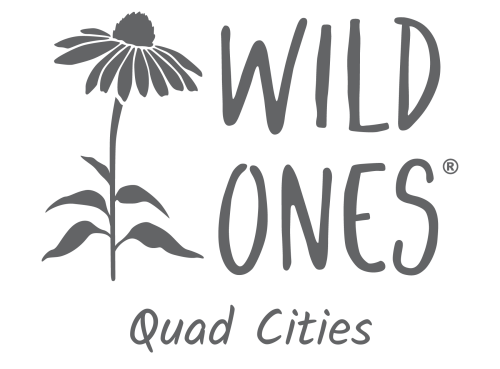By Gina Bartleson
My pollinator garden, located in Iowa City, began 8 years ago this year. It’s a continual work in progress. Each year, we have converted more of our yard to pollinator habitat. Each year, more native plants are added and the ones we already planted creep and expand. Each year, we see more insects, birds, and other animals benefiting from the mini-ecosystem we’ve tried to create.
The pinks and purples of May linger in many of these June blooming species but with splashes of bright orange as spring turns to summer. Now we see bumblebee workers, and not the queens, doing the foraging work and the diversity of insects feeding and sheltering in our plants increases as the days lengthen and warm.

Harebell (Campanula rotundifolia), a delicate plant about a foot tall, is planted in my front and backyard. It’s not picky where it grows as long as it gets lots of sunlight. Mine has spread modestly and bloomed from June into October last year. Small bees visit the flowers but mammalian herbivores seem to leave them alone for the most part. Keep more aggressive plants away and harebells are an excellent edge plant in the garden.

American Ipecac (Porteranthus stipulatus), also known as Indian Physic (Gillenia stipulata), is an understated plant with unique toothy leaves and dainty flowers. It doesn’t bloom long and its beauty can get lost among the more showy forbs this time of year. However, with its appeal to pollinators, resistance to herbivores due to toxic foliage, and ability to thrive in a variety of conditions, it’s a great plant to add to a pollinator garden.
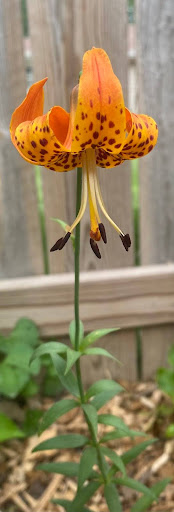
Michigan Lily
The stunning Michigan Lily (Lilium michiganense) is a plant that I’ve been unable to get established in our yard: likely due to its preference for loamy soil and moist conditions and my yard’s predominantly clay soil and medium to dry conditions. I’m hoping this year, my new lily is finally in an acceptable location and since it bloomed, I’m cautiously optimistic! I bought two plugs from Allendan Seed this spring since they need to be cross-pollinated to produce seeds. Their pollinators include hummingbirds and large butterflies and moths.
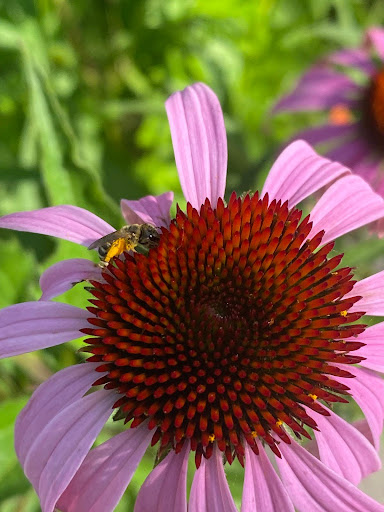
Purple Coneflower
The ubiquitous purple coneflower (Echinacea purpurea) is popular in pollinator gardens for very good reasons. It’s beautiful, attracts pollinators, and easily grown in most conditions. Starting these flowers from seed is easy as they don’t require stratification: even I’ve been able to do it and I’m terrible at starting plants from seed! Here a native bee species, probably Halictus ligatus (thanks to a bee ID expert friend!), is enjoying one of our garden’s coneflowers.
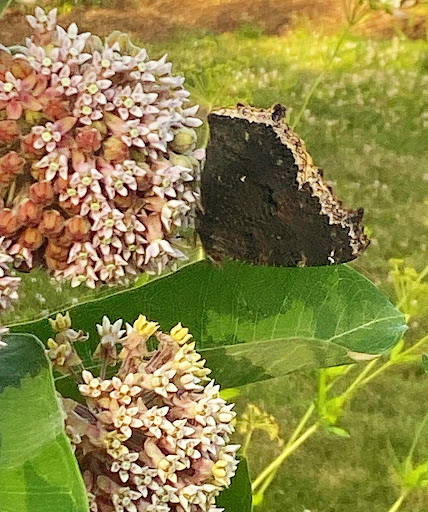
Common milkweed (Asclepias syriaca) is another popular pollinator garden plant: primarily because it’s one of the host plants of the monarch butterfly (Danaus plexippus) but it also holds appeal for how easy it is to establish and it’s beautiful flowers that attract a variety of other pollinators and other insects use milkweed for food and shelter. Here you see a Mourning Cloak butterfly (Nymphalis antiopa) enjoying the common milkweed that we are finding more of each year in our garden.
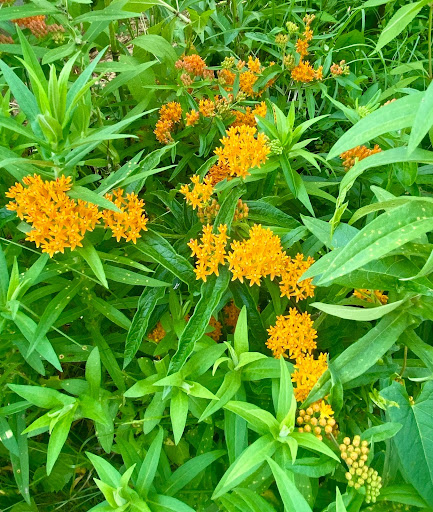
Another milkweed to include in your pollinator garden is the striking Butterfly Milkweed (Asclepias tuberosa): not to be confused with Butterfly Bush (Buddleia spp.), an invasive non-native ornamental. This vibrant milkweed is almost a neon orange, an uncommon color among most native plants, which adds visual appeal to the garden as it stands out among the pinks and purples of June. I’ve been told that Butterfly Milkweed is one of the best pollinator plants to include in your garden: not only is it a host plant for the monarch butterfly whose populations have decreased by almost a billion since 1990 (United States Fish and Wildlife Service, 2015) but it also attracts a wide variety of native bees and other important pollinators.It also is more “well-behaved” than common milkweed and doesn’t spread as aggressively. Our butterfly milkweed is getting overtaken by New England aster and Joe Pye Weed in this picture; we will be moving those species to a newer part of our garden to give the butterfly weed space to thrive and spread.
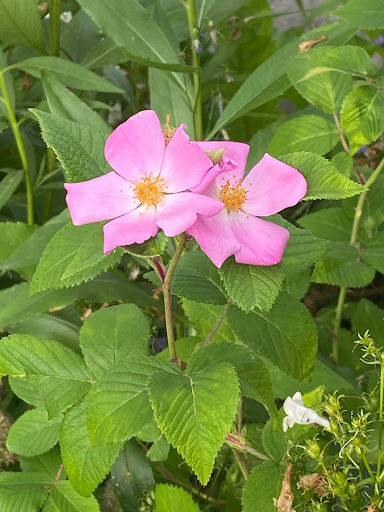
Climbing Wild Rose
Our wooden wedding arch is part of our garden and I’ve been looking for a native plant species to climb the arch. I first started with what I thought was American bittersweet (Celastrus scandens) that I bought from a “native plant” nursery from the local farmer’s market. Unfortunately, when I got the plants, it turned out to be a hybrid of American bittersweet and the noxious invasive non-native Asiatic bittersweet (Celastrus orbiculatus). So that was immediately destroyed! This is the next choice: Climbing Wild Rose (Rosa setigera). We planted the bare roots last year and they grew sluggishly, likely due to the drought. This year, they are growing much faster and putting out these beautiful pink blooms. Like other roses, they do have thorns so we are very carefully training them to climb.
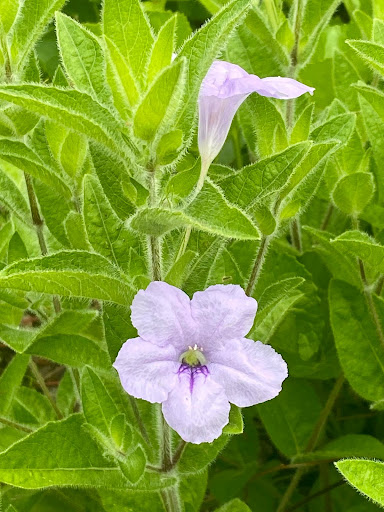
The wild hairy petunia (Ruellia humilis) was just added to our front yard garden last year and should be used by more pollinator gardeners! It’s a great edge plant, only about a foot tall, and very adaptable to many conditions: it thrives in full to partial sun and moist to dry conditions. It blooms for about two months and attracts many species of pollinators and is a host plant for the Buckeye butterfly (Junonia coenia).
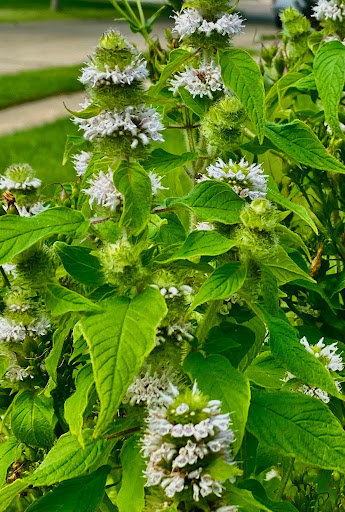
Bumble bees love our hairy wood mint (Blephilia hirsuta). It does better in our backyard where it gets more shade and richer soil vs. our front yard that’s been much more sunny since we lost both of our trees last year. It’s doing much better this year than last year as it’s a species that prefers wetter soils. The abundant deer in our neighborhood seem to avoid this species while chowing down on our asters nearby.
See you in July!
Gina
Thank you so much for your contribution, Gina!
If you would like to submit a blog post, please contact our web chair, Emma Harmon, at [email protected]
